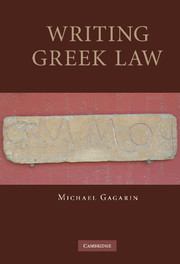Book contents
- Frontmatter
- Contents
- List of illustrations
- Preface and Acknowledgments
- List of abbreviations
- Introduction: Writing Greek Law
- Chapter 1 Law before Writing
- Chapter 2 Writing and Written Laws
- Chapter 3 Why the Greeks Wrote Laws
- Chapter 4 Why Draco Wrote his Homicide Law
- Chapter 5 Oral and Written in Archaic Greek Law
- Chapter 6 Writing Laws in Fifth-Century Gortyn
- Chapter 7 Writing the Gortyn Code
- Chapter 8 Writing Law in Classical Athens
- Chapter 9 Writing Athenian Law: a Comparative Perspective
- Chapter 10 Writing Law in Hellenistic Greece
- Conclusion: Writing Greek Law
- Appendices
- Bibliography
- Index Locorum
- Subject Index
Chapter 9 - Writing Athenian Law: a Comparative Perspective
Published online by Cambridge University Press: 22 September 2009
- Frontmatter
- Contents
- List of illustrations
- Preface and Acknowledgments
- List of abbreviations
- Introduction: Writing Greek Law
- Chapter 1 Law before Writing
- Chapter 2 Writing and Written Laws
- Chapter 3 Why the Greeks Wrote Laws
- Chapter 4 Why Draco Wrote his Homicide Law
- Chapter 5 Oral and Written in Archaic Greek Law
- Chapter 6 Writing Laws in Fifth-Century Gortyn
- Chapter 7 Writing the Gortyn Code
- Chapter 8 Writing Law in Classical Athens
- Chapter 9 Writing Athenian Law: a Comparative Perspective
- Chapter 10 Writing Law in Hellenistic Greece
- Conclusion: Writing Greek Law
- Appendices
- Bibliography
- Index Locorum
- Subject Index
Summary
In Chapter Seven, we contrasted the use of writing in connection with law at Gortyn, where legislation was routinely written down and displayed in public, but writing had little or no presence in judicial procedure, with the very different use of writing in the laws of Hammurabi. Now that we have established a similar pattern in the use of writing in Athenian law, we can extend this contrast to two other premodern legal systems, early Roman law and early English common law. But first, let me extend the observations made in Chapter Eight about the use of writing to other features of Athenian law that are related to the ways in which writing was used.
As we have seen, from its very beginning in the late seventh century, Athenian legislation was written down and publicly displayed. Moreover, Draco and his successors strove to make the laws as accessible as possible to all members of the community who might wish to make use of them. In other words, Athenians always assumed that legislation was a matter of public interest and should be available to the public. Athenian law also displays from the beginning a reluctance to use writing for procedural matters or to insert writing into the traditionally oral trial process.
- Type
- Chapter
- Information
- Writing Greek Law , pp. 206 - 224Publisher: Cambridge University PressPrint publication year: 2008



